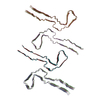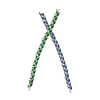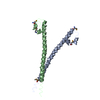+ Open data
Open data
- Basic information
Basic information
| Entry | Database: PDB / ID: 7qkl | ||||||
|---|---|---|---|---|---|---|---|
| Title | In vitro assembled 266/297 - 391 tau filaments with ZnCl2 (11a) | ||||||
 Components Components | Microtubule-associated protein tau | ||||||
 Keywords Keywords | PROTEIN FIBRIL / Alzheimer's Disease / Amyloid / Tau / Neurodegeneration | ||||||
| Function / homology |  Function and homology information Function and homology informationplus-end-directed organelle transport along microtubule / histone-dependent DNA binding / negative regulation of establishment of protein localization to mitochondrion / neurofibrillary tangle / microtubule lateral binding / axonal transport / main axon / phosphatidylinositol bisphosphate binding / regulation of long-term synaptic depression / tubulin complex ...plus-end-directed organelle transport along microtubule / histone-dependent DNA binding / negative regulation of establishment of protein localization to mitochondrion / neurofibrillary tangle / microtubule lateral binding / axonal transport / main axon / phosphatidylinositol bisphosphate binding / regulation of long-term synaptic depression / tubulin complex / positive regulation of protein localization to synapse / negative regulation of tubulin deacetylation / generation of neurons / regulation of chromosome organization / rRNA metabolic process / axonal transport of mitochondrion / regulation of mitochondrial fission / axon development / central nervous system neuron development / intracellular distribution of mitochondria / regulation of microtubule polymerization / microtubule polymerization / lipoprotein particle binding / minor groove of adenine-thymine-rich DNA binding / dynactin binding / negative regulation of mitochondrial membrane potential / apolipoprotein binding / axolemma / protein polymerization / glial cell projection / negative regulation of mitochondrial fission / Caspase-mediated cleavage of cytoskeletal proteins / regulation of microtubule polymerization or depolymerization / positive regulation of axon extension / neurofibrillary tangle assembly / Activation of AMPK downstream of NMDARs / regulation of cellular response to heat / synapse assembly / supramolecular fiber organization / positive regulation of protein localization / regulation of calcium-mediated signaling / somatodendritic compartment / cellular response to brain-derived neurotrophic factor stimulus / cytoplasmic microtubule organization / positive regulation of microtubule polymerization / axon cytoplasm / stress granule assembly / phosphatidylinositol binding / regulation of microtubule cytoskeleton organization / nuclear periphery / protein phosphatase 2A binding / positive regulation of superoxide anion generation / cellular response to reactive oxygen species / astrocyte activation / Hsp90 protein binding / microglial cell activation / cellular response to nerve growth factor stimulus / response to lead ion / synapse organization / PKR-mediated signaling / protein homooligomerization / regulation of synaptic plasticity / SH3 domain binding / memory / microtubule cytoskeleton organization / cytoplasmic ribonucleoprotein granule / neuron projection development / cell-cell signaling / single-stranded DNA binding / protein-folding chaperone binding / actin binding / cellular response to heat / microtubule cytoskeleton / cell body / growth cone / double-stranded DNA binding / microtubule binding / protein-macromolecule adaptor activity / dendritic spine / sequence-specific DNA binding / amyloid fibril formation / microtubule / learning or memory / neuron projection / regulation of autophagy / membrane raft / axon / negative regulation of gene expression / neuronal cell body / dendrite / DNA damage response / protein kinase binding / enzyme binding / mitochondrion / DNA binding / RNA binding / extracellular region / identical protein binding / nucleus / plasma membrane Similarity search - Function | ||||||
| Biological species |  Homo sapiens (human) Homo sapiens (human) | ||||||
| Method | ELECTRON MICROSCOPY / helical reconstruction / cryo EM / Resolution: 2.07 Å | ||||||
 Authors Authors | Lovestam, S. / Scheres, S.H.W. | ||||||
| Funding support |  United Kingdom, 1items United Kingdom, 1items
| ||||||
 Citation Citation |  Journal: Elife / Year: 2022 Journal: Elife / Year: 2022Title: Assembly of recombinant tau into filaments identical to those of Alzheimer's disease and chronic traumatic encephalopathy. Authors: Sofia Lövestam / Fujiet Adrian Koh / Bart van Knippenberg / Abhay Kotecha / Alexey G Murzin / Michel Goedert / Sjors H W Scheres /   Abstract: Abundant filamentous inclusions of tau are characteristic of more than 20 neurodegenerative diseases that are collectively termed tauopathies. Electron cryo-microscopy (cryo-EM) structures of tau ...Abundant filamentous inclusions of tau are characteristic of more than 20 neurodegenerative diseases that are collectively termed tauopathies. Electron cryo-microscopy (cryo-EM) structures of tau amyloid filaments from human brain revealed that distinct tau folds characterise many different diseases. A lack of laboratory-based model systems to generate these structures has hampered efforts to uncover the molecular mechanisms that underlie tauopathies. Here, we report in vitro assembly conditions with recombinant tau that replicate the structures of filaments from both Alzheimer's disease (AD) and chronic traumatic encephalopathy (CTE), as determined by cryo-EM. Our results suggest that post-translational modifications of tau modulate filament assembly, and that previously observed additional densities in AD and CTE filaments may arise from the presence of inorganic salts, like phosphates and sodium chloride. In vitro assembly of tau into disease-relevant filaments will facilitate studies to determine their roles in different diseases, as well as the development of compounds that specifically bind to these structures or prevent their formation. | ||||||
| History |
|
- Structure visualization
Structure visualization
| Movie |
 Movie viewer Movie viewer |
|---|---|
| Structure viewer | Molecule:  Molmil Molmil Jmol/JSmol Jmol/JSmol |
- Downloads & links
Downloads & links
- Download
Download
| PDBx/mmCIF format |  7qkl.cif.gz 7qkl.cif.gz | 117.1 KB | Display |  PDBx/mmCIF format PDBx/mmCIF format |
|---|---|---|---|---|
| PDB format |  pdb7qkl.ent.gz pdb7qkl.ent.gz | 75.1 KB | Display |  PDB format PDB format |
| PDBx/mmJSON format |  7qkl.json.gz 7qkl.json.gz | Tree view |  PDBx/mmJSON format PDBx/mmJSON format | |
| Others |  Other downloads Other downloads |
-Validation report
| Summary document |  7qkl_validation.pdf.gz 7qkl_validation.pdf.gz | 1.1 MB | Display |  wwPDB validaton report wwPDB validaton report |
|---|---|---|---|---|
| Full document |  7qkl_full_validation.pdf.gz 7qkl_full_validation.pdf.gz | 1.1 MB | Display | |
| Data in XML |  7qkl_validation.xml.gz 7qkl_validation.xml.gz | 32.9 KB | Display | |
| Data in CIF |  7qkl_validation.cif.gz 7qkl_validation.cif.gz | 46.6 KB | Display | |
| Arichive directory |  https://data.pdbj.org/pub/pdb/validation_reports/qk/7qkl https://data.pdbj.org/pub/pdb/validation_reports/qk/7qkl ftp://data.pdbj.org/pub/pdb/validation_reports/qk/7qkl ftp://data.pdbj.org/pub/pdb/validation_reports/qk/7qkl | HTTPS FTP |
-Related structure data
| Related structure data |  14046MC  7qjvC  7qjwC  7qjxC  7qjyC  7qjzC  7qk1C  7qk2C  7qk3C  7qk5C  7qk6C  7qkfC  7qkgC  7qkhC  7qkiC  7qkjC  7qkkC  7qkmC  7qkuC  7qkvC  7qkwC  7qkxC  7qkyC  7qkzC  7ql0C  7ql1C  7ql2C  7ql3C  7ql4C  7r4tC  7r5hC M: map data used to model this data C: citing same article ( |
|---|---|
| Similar structure data | |
| EM raw data |  EMPIAR-10940 (Title: Tutorial for high-throughput cryo-EM structure determination of amyloids: Dataset 1 EMPIAR-10940 (Title: Tutorial for high-throughput cryo-EM structure determination of amyloids: Dataset 1Data size: 476.1 Data #1: Unaligned multi-frame movies in Tiff: Dataset 1 [micrographs - multiframe]) |
- Links
Links
- Assembly
Assembly
| Deposited unit | 
|
|---|---|
| 1 |
|
- Components
Components
| #1: Protein | Mass: 45919.871 Da / Num. of mol.: 6 Source method: isolated from a genetically manipulated source Source: (gene. exp.)  Homo sapiens (human) / Gene: MAPT, MAPTL, MTBT1, TAU / Production host: Homo sapiens (human) / Gene: MAPT, MAPTL, MTBT1, TAU / Production host:  |
|---|
-Experimental details
-Experiment
| Experiment | Method: ELECTRON MICROSCOPY |
|---|---|
| EM experiment | Aggregation state: FILAMENT / 3D reconstruction method: helical reconstruction |
- Sample preparation
Sample preparation
| Component | Name: Tau / Type: COMPLEX / Entity ID: all / Source: RECOMBINANT |
|---|---|
| Molecular weight | Experimental value: NO |
| Source (natural) | Organism:  Homo sapiens (human) Homo sapiens (human) |
| Source (recombinant) | Organism:  |
| Buffer solution | pH: 7.4 |
| Specimen | Embedding applied: NO / Shadowing applied: NO / Staining applied: NO / Vitrification applied: YES |
| Vitrification | Cryogen name: ETHANE |
- Electron microscopy imaging
Electron microscopy imaging
| Experimental equipment |  Model: Titan Krios / Image courtesy: FEI Company |
|---|---|
| Microscopy | Model: FEI TITAN KRIOS |
| Electron gun | Electron source:  FIELD EMISSION GUN / Accelerating voltage: 300 kV / Illumination mode: FLOOD BEAM FIELD EMISSION GUN / Accelerating voltage: 300 kV / Illumination mode: FLOOD BEAM |
| Electron lens | Mode: BRIGHT FIELD / Nominal defocus max: 3500 nm / Nominal defocus min: 1000 nm |
| Image recording | Electron dose: 40 e/Å2 / Film or detector model: FEI FALCON IV (4k x 4k) |
- Processing
Processing
| EM software | Name: RELION / Version: 4 / Category: 3D reconstruction / Details: Good programme |
|---|---|
| CTF correction | Type: PHASE FLIPPING AND AMPLITUDE CORRECTION |
| Helical symmerty | Angular rotation/subunit: 179.402 ° / Axial rise/subunit: 2.378 Å / Axial symmetry: C1 |
| 3D reconstruction | Resolution: 2.07 Å / Resolution method: FSC 0.143 CUT-OFF / Num. of particles: 74337 / Symmetry type: HELICAL |
| Atomic model building | Protocol: AB INITIO MODEL |
 Movie
Movie Controller
Controller



































 PDBj
PDBj





